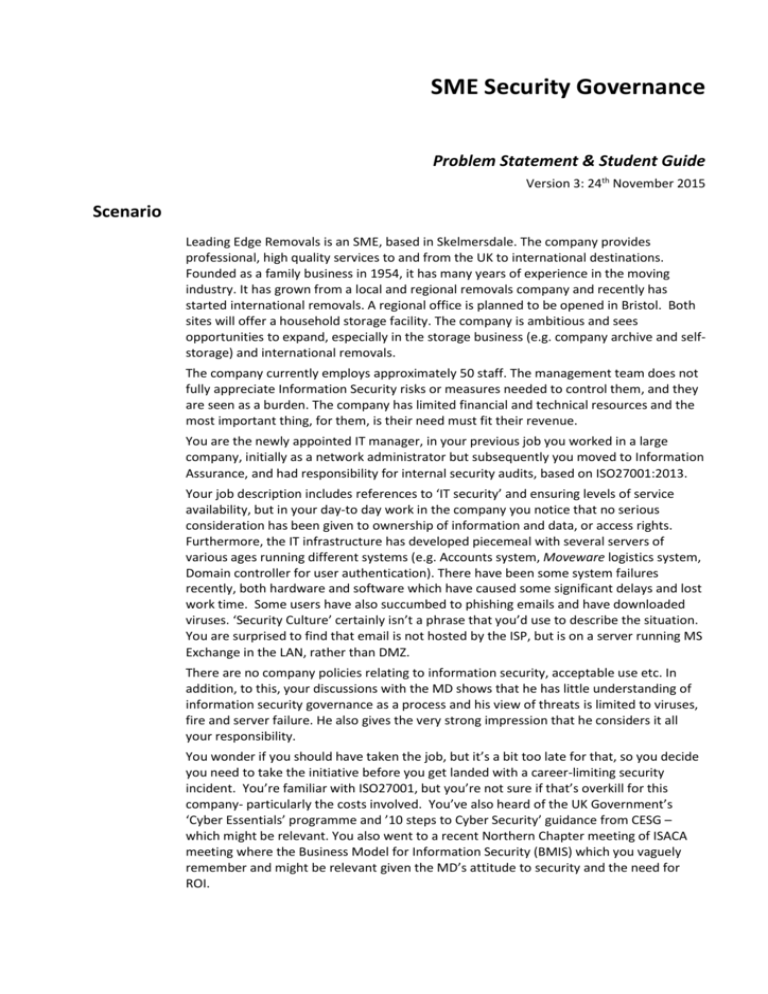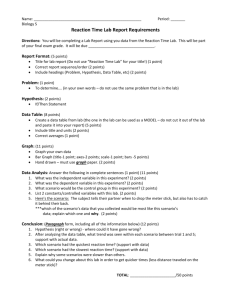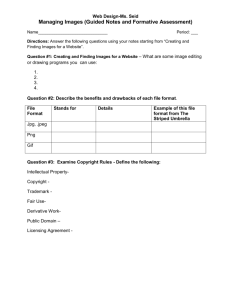Problem Statement - Cyber Security Knowledge Exchange
advertisement

SME Security Governance Problem Statement & Student Guide Version 3: 24th November 2015 Scenario Leading Edge Removals is an SME, based in Skelmersdale. The company provides professional, high quality services to and from the UK to international destinations. Founded as a family business in 1954, it has many years of experience in the moving industry. It has grown from a local and regional removals company and recently has started international removals. A regional office is planned to be opened in Bristol. Both sites will offer a household storage facility. The company is ambitious and sees opportunities to expand, especially in the storage business (e.g. company archive and selfstorage) and international removals. The company currently employs approximately 50 staff. The management team does not fully appreciate Information Security risks or measures needed to control them, and they are seen as a burden. The company has limited financial and technical resources and the most important thing, for them, is their need must fit their revenue. You are the newly appointed IT manager, in your previous job you worked in a large company, initially as a network administrator but subsequently you moved to Information Assurance, and had responsibility for internal security audits, based on ISO27001:2013. Your job description includes references to ‘IT security’ and ensuring levels of service availability, but in your day-to day work in the company you notice that no serious consideration has been given to ownership of information and data, or access rights. Furthermore, the IT infrastructure has developed piecemeal with several servers of various ages running different systems (e.g. Accounts system, Moveware logistics system, Domain controller for user authentication). There have been some system failures recently, both hardware and software which have caused some significant delays and lost work time. Some users have also succumbed to phishing emails and have downloaded viruses. ‘Security Culture’ certainly isn’t a phrase that you’d use to describe the situation. You are surprised to find that email is not hosted by the ISP, but is on a server running MS Exchange in the LAN, rather than DMZ. There are no company policies relating to information security, acceptable use etc. In addition, to this, your discussions with the MD shows that he has little understanding of information security governance as a process and his view of threats is limited to viruses, fire and server failure. He also gives the very strong impression that he considers it all your responsibility. You wonder if you should have taken the job, but it’s a bit too late for that, so you decide you need to take the initiative before you get landed with a career-limiting security incident. You’re familiar with ISO27001, but you’re not sure if that’s overkill for this company- particularly the costs involved. You’ve also heard of the UK Government’s ‘Cyber Essentials’ programme and ’10 steps to Cyber Security’ guidance from CESG – which might be relevant. You also went to a recent Northern Chapter meeting of ISACA meeting where the Business Model for Information Security (BMIS) which you vaguely remember and might be relevant given the MD’s attitude to security and the need for ROI. Learning Outcomes The specific learning outcomes will depend on how the scenario is used. The following are suggested technical learning outcomes. On completion of the scenario, students will be able to: 1. Articulate the major security risks and legal compliance issues for an SME. 2. Explain approaches to justification of investment on Infosec controls, including ROSI (Return on Security Investment). 3. Explain the key features of ISO27001 and risk assessment 4. Explain key features and requirements for an Information Security culture and suggest activities for developing it. 5. Analyse and discuss the relevance of Cyber Essentials and BMIS to the scenario. 6. Identify and outline key policies required and HR processes. 7. Identify and justify technical controls for securing remote access and data governance. Your Task – Stage 1: Analysis Analyse the scenario above, identify aspects of it that you do not understand and need to research before moving forward. Then create and deliver a presentation which discusses the following. 1. What do you see as the major security issues here? 2. An outline plan of action to improve the security of this company. 3. What further information do you need from the company in order to propose a way forward? Your Task – Stage 2: Proposal and Plan Using the additional information you’ve obtained from the company, together with your research you should now consider the detailed actions that need to be taken to increase security, There are two deliverables: 1. A plan for influencing the board (actions/supporting information needed/ presentation) 2. A detailed proposal for securing the company assets and developing a security culture. It should identify key assets, risk, controls, (particularly data governance) and ROSI. 3. You will present your proposal to the board. Reflection on Learning It is also important that at the end of the scenario you should reflect on your learning and team working and identify what worked well, what didn’t and actions for future improvement. The Consulting Process One of the benefits of Problem-based Learning is that you learn professional skills as well as technical knowledge. The process we ask you to follow to explore and provide solutions to the problem also mirror those used in consultancy. In order to assist you with the process, the following table shows the activities we would expect you to complete in your PBL team. You should read this carefully and make sure you are familiar with both the generic activities (in column 2) and the specific ones in column 3. Steps 1 & 2 will be conducted in the first PBL tutorial. Step 3 a) and b) comprises your individual research, and summarizing your learning. Step 3 c) takes place as a sharing and teaching session at the next tutorial. This process of sharing and teaching others is extremely beneficial to your own learning. Step 4, 5, 6 consist of team work and whilst they are logically distinct, they may take place at the same meeting as stage 3c) depending on the schedule of meetings. Step 7: In this Scenario you will not be implementing a solution, so step 7 is not undertaken in this scenario Step 8 should be completed at the end of the scenario, both individually and as a team, to identify what you’ve learned and how you can improve your learning and team performance in future. Your tutor/ facilitator will discuss it with you. The CSKE Consulting/ Learning Model Problem-solving model 1 Understanding organizational history and context What PBL normally includes’ 2 Determining the problem to be resolved a) Scenario analysis Socio-technical organizational analysis. Clarification of ambiguities Requirements Analysis: identify key issues Simulated consultation with stakeholders (e.g. through role-play and/or online interaction). Reviewing technology/ processes in use. What you will be doing at each stage b) c) a) b) c) 3 Identifying/ learning necessary knowledge 4 Identifying alternative solutions 5 6 7 8 Choosing optimal solution Planning the implementation Implementation Individual research & learning to resolve knowledge gaps. Summarising & reflection. Teams share learning. Determining and agreeing evaluation criteria and process. Identifying technical possibilities, considering acceptance issues and organizational fit. Facilitator Guidance. Deciding on best technical, organizational and social outcomes. Proposing solution with justification Applying planning and scheduling techniques. Proposing plan and deadlines. Building the solution (if appropriate). Deploying the solution (if appropriate). Formal evaluation methods re project success. Personal reflection and evaluation. Final evaluation Team review of scenario: identifying key issues. Identifying learning goals. Team publish action list & summary in forum. Identifying learning goals. Facilitator Guidance. a) Individual and team review of scenario text and video resources. Team discussion. Clarification of ambiguities with tutor/facilitator. b) c) a) Individual research & learning to resolve knowledge gaps. Individually creating summary of learning and how it applies to the scenario. Team sharing learning/ teach each other. c) Determining evaluation criteria through team discussion. Team identification of options considering acceptance issues and organizational fit. Facilitator Guidance. a) Team decision and justification. a) b) c) d) Review Scenario text and resources. Produce Report. Produce plan/schedule. Presentation to tutor in role of main stakeholders. a) Team evaluation of performance and project success. Individual reflection on personal learning & development. b) b) Resources Alnatheer, M., Chan, T. & Nelson, K. (2012) Understanding And Measuring Information Security Culture. Proceedings of the Pacific Asia Conference on Information Systems A useful review of Security culture factors, followed by development of metrics, which are probably less useful for this task.. Bojanc,R., Borka J. (2008) An economic modelling approach to information security risk management. International Journal of Information Management.28, 413–422 The paper introduces methods for identification of the assets, the threats, the vulnerabilities and Risk of systems and proposes a procedure that enables selection of the optimal investment of the necessary security technology based on the quantification of the values of the protected systems. This paper analyzes several approaches enabling assessment of the necessary investment in security technology from the economic point of view. Useful to discuss ROSI. Brecht, M & Nowey, RT. (2012) A Closer Look at Information Security Costs, http://weis2012.econinfosec.org/papers/Brecht_WEIS2012.pdf [Last accessed 29-May2015] This paper is useful for discussing ROSI. It identifies and describes the problems and difficulties in quantifying an enterprise's cost for information security in a comprehensive way. The paper discusses four approaches to categorise and determine information security costs in an enterprise. Not as good as Sonnerich (see below) in my opinion, but useful. British Standards ISO 27001 Overview: http://www.bsigroup.com/en-GB/iso-27001information-security/ [Last accessed 22-Nov-2015] A very useful introduction to ISO27001, before looking at the standards documents themselves. HM Government (2015) Small businesses: what you need to know about cyber security: DBIS. https://www.gov.uk/government/uploads/system/uploads/attachment_data/file/412017 /BIS-15-147-small-businesses-cyber-guide-March-2015.pdf [Last accessed 22-Nov-2015] An excellent, introductory overview to information security. A good starting point. ISACA, 2013. CISM Review Manual. Rolling Meadows: ISACA. The CISM review manuals provide detailed, though quite dense discussion of the knowledge, skills and tasks associated with each of the CISM domains. A p[particularly useful aspect is the inclusion of test questions (and answers) which are very thought provoking and good for discussion. ISO 22301:2012 Societal security -- Business continuity management systems --Requirements A related standard that clearly is relevant, but more detailed than necessary for this scenario ISO/IEC 27001:2013 Information technology — Security techniques — Information security management systems — Requirements A surprisingly readable and brief standard that is well-worth reading for this scenario. ISO/IEC 27002:2013 Information technology — Security techniques — Code of practice for information security controls The partner to ISO27001, providing details of the controls, a useful reference document to help explain the annex in ISO27001. ISO/IEC 27035:2011 Information technology — Security techniques — Information security incident management This standard is being updated, 2011 is the old version. There is increasing acknowledgement that the question of how to respond to incidents is one of the most critical, it is not a matter of if you will suffer, but when. Thus, increased emphasis on incident management is important. Melek,A. (2014) Cybersecurity: engaging with the board, ISACA A 31-slide presentation which provides a nice overview, discussing the threat landscape, lessons from the past, actions to improve cyber defences and key considerations for the Board and senior managers. Posthumus, S., & Von Solms, R. (2004). A framework for the governance of information security. Computers & Security, 23(8), pp. 638-646. [Online]. Available from: http://www.sciencedirect.com/science/article/pii/S0167404804002639 [Accessed on 22/11/2015] Whilst this is not a new article, it is a good discussion of Information Security Governance. Sonnenreich,W. Albanese,J. and Stout,B. (2006) Return on Security Investment (ROSI) – A Practical Quantitative Model, Journal of Research and Practice in Information Technology, 38, 1, A paper that is well-written and essential reading for ROSI in this scenario. Stuntz,J. (2014) A Review of Return on Investment for Cybersecurity , McDonough School of Business Provides a good overview of ROSI. Not as detailed as Sonnereich Von Solms, R., Thomson, K. L., & Maninjwa, M. (2011). Information security governance control through comprehensive policy architectures. In Information Security South Africa (ISSA), (pp. 1-6). IEEE. [Online]. Available from: http://ieeexplore.ieee.org/xpls/abs_all.jsp?arnumber=6027522, [Accessed on 11/03/2015] A short (6-page) conference paper that gives a useful overview of InfoSec governance and argues for a “more complete information security policy architecture that will facilitate complete control, and therefore compliance, to ensure sound Information Security Governance.” Assessment Grading Criteria Learning Outcome LO1. Articulate the major security risks and legal compliance issues for an SME. LO2. Explain approaches to justification of investment on Infosec controls, including ROSI (Return on Security Investment). LO3. Explain the key features of ISO27001 and risk assessment LO4. Explain key features and requirements for an Information Security culture and suggest activities for developing it. LO5. Analyse and discuss the relevance of Cyber Essentials and BMIS to the scenario. LO6. Identify and outline key policies required and HR processes. LO7. Identify and justify technical controls for securing remote access and data governance. Working With Others: Participate constructively in team by Taking responsibility, Showing sensitivity and provide supportive feedback to others, Meeting deadlines Evidence (graded on) Pass (40-49%) Most appropriate threats, vulnerabilities and reasoned risk levels assigned. Appropriate risk treatment measures for major risks. Security culture and standards discussed briefly. Team Report Sound Pass (50-59%) Very Good Pass (60-69%) Almost all threats and risks identified correctly and in suitable format, and prioritised appropriately. Addresses all major risks, with appropriate controls. Links are made between risks/threats and solutions, including culture. Most risks relating to legal regulations explicitly identified. Some risks relating to legal regulations explicitly identified. Clear links to ISO27k, BMIS and Cyber Essentials. Some indicators of Return on Key points of ROSI explicitly Investment identified discussed Reports are structured with appropriate headings. Alternatives are discussed, but may be briefly. Acceptable spelling and grammar. Report structured with appropriate headings. Mostly relevant content. Generally appropriate level of detail, but inconsistent Presentation is As pass and presentation consistent with, emphasises key points and has report. balanced content. Timekeeping, oral contributions, VLE postings, timeliness of work produced. Usually communicates quickly with others if problems attending or meeting commitments, On time for most meetings, Completes most work allocated. NB Students can be excluded from teams for not meeting these requirements. As sound pass and presentation clearly links features/ benefits of solution with client needs and problems. Weight Comprehensive list of threats, risks, Consistent treatment of and impact clearly related and in assets/threats/risks, correct id & in suitable format, evaluated and suitable format. prioritised appropriately. As sound pass and clearly linked to Report is detailed, addresses all most requirements. Benefits of major risks, appropriate controls, solution identified. including culture, clearly linked to most requirements and critical Systematic and complete evaluation of alternate solutions treatment of legal regulations. provided. ISO27k, BMIS and Cyber Systematic and complete treatment Essentials. integrated into the of legal regulations. report Convincing discussion of ROSI. Alternatives are discussed highlighting key issues. Written in clear consistent and appropriate (business) style of English. Technical detail explained appropriately. 70% ISO27k, BMIS and Cyber Essentials. integrated into the report Convincing discussion of ROSI. Alternatives are discussed critically highlighting key issues complete/consistent solution. Clear, concise and complete with appropriate level of detail throughout almost all report. Presentation is persuasive, balanced, thorough and clearly Presentation is consistent with, and links features/benefits of solution relates to report. to client needs/problems Considered reliable by team mates. Almost always communicates As Sound pass and on time for quickly with others & renegotiates if almost all meetings, Completes all problems attending or meeting work as agreed. commitments, Shares work with others in timely way. 7 Excellent (70-100%) As Very good pass and shows initiative / leadership in some areas of work. 20% 10%




